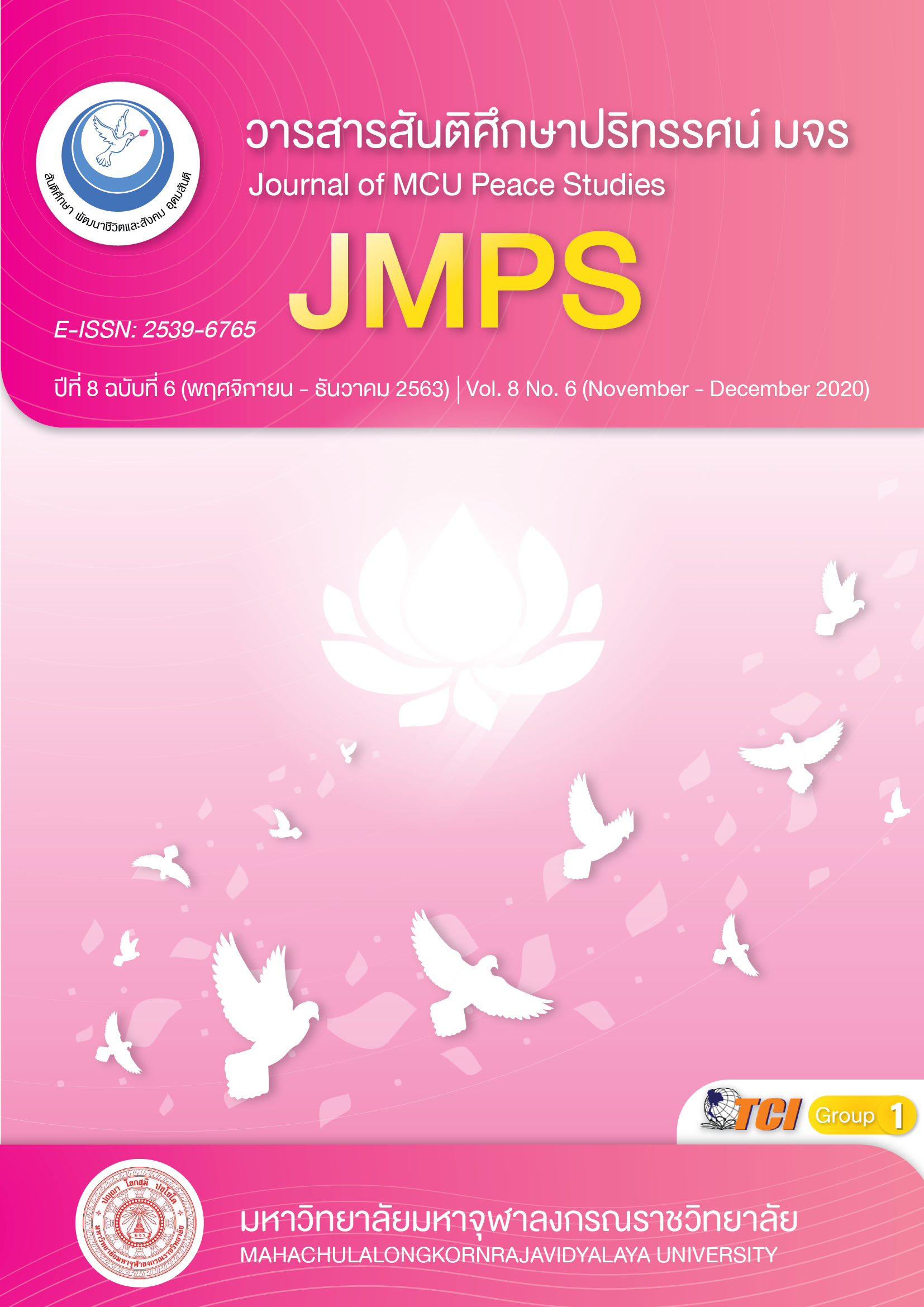ปัจจัยที่มีผลต่อการบริหารจัดการตลาดเสื้อผ้าเด็กในส่วนตลาดไฮเปอร์มาร์เก็ต
Main Article Content
บทคัดย่อ
บทความวิจัยนี้ มีวัตถุประสงค์เพื่อศึกษา 1) ระดับความสำคัญของปัจจัยที่มีอิทธิพลกับการบริหารจัดการตลาดเสื้อผ้าเด็กในตลาดไฮเปอร์มาร์เก็ต 2) ความสัมพันธ์ของส่วนประสมการตลาด พฤติกรรมผู้บริโภค และความภักดีต่อตราสินค้าที่มีอิทธิพลต่อการบริหารจัดการตลาดเสื้อผ้าเด็กในตลาดไฮเปอร์มาร์เก็ต เป็นการวิจัยแบบผสานวิธี กลุ่มตัวอย่าง คือ ผู้บริโภคที่ซื้อเสื้อผ้าเด็ก หรือเคยซื้อเสื้อผ้าเด็กในตลาดไฮเปอร์มาร์เกตในเขตกรุงเทพมหานคร ใช้วิธีการสุ่มกลุ่มตัวอย่างแบบกลุ่ม และผู้เชี่ยวชาญด้านการตลาด ผู้ประกอบธุรกิจ หรือผู้ที่มีความเกี่ยวข้องกับตลาดเสื้อผ้าเด็ก ใช้วิธีการสุ่มตัวอย่างแบบเฉพาะเจาะจง เครื่องมือที่ใช้ในการเก็บข้อมูล คือ แบบสอบถาม แบบสัมภาษณ์เชิงลึก สถิติที่ใช้ในการวิเคราะห์ข้อมูล คือ สถิติเชิงพรรณนา และการวิเคราะห์สมการโครงสร้าง ผลการวิจัยพบว่า 1) ระดับความสำคัญของปัจจัยที่มีอิทธิพลกับการบริหารจัดการตลาดเสื้อผ้าเด็กในตลาดไฮเปอร์มาร์เก็ต คือ ส่วนประสมทางการตลาด พฤติกรรมผู้บริโภค ความภักดีต่อตราสินค้า และการบริหารจัดการตลาดเสื้อผ้าเด็กซึ่งระดับความคิดของผู้ตอบแบบสอบถามอยู่ในระดับดีมาก 2) แบบจำลองสมการโครงสร้าง พบว่า ส่วนประสมการตลาด พฤติกรรมผู้บริโภค และความภักดีต่อตราสินค้าที่มีอิทธิพลต่อการบริหารจัดการตลาดเสื้อผ้าเด็กในตลาดไฮเปอร์มาร์เก็ต นอกจากนี้ ผลการวิเคราะห์ข้อมูลเชิงปริมาณมีผลสอดคล้องกับวรรณกรรมที่เกี่ยวข้องและข้อมูลเชิงคุณภาพโดยกลุ่มตัวอย่างเห็นว่าพฤติกรรมผู้บริโภคมีความสำคัญอย่างยิ่งในตลาดเป้าหมายและดึงดูดลูกค้า ดังนั้นทุกองค์ประกอบส่วนประสมการตลาดจะต้องผสมผสานและดำเนินการเอื้อประโยชน์ซึ่งกันและกันได้ เป็นปัจจัยสำคัญที่ทำให้ธุรกิจตลาดเสื้อผ้าเด็กในตลาดไฮเปอร์มาร์เก็ตประสบความสำเร็จ
Article Details
ทัศนะและความคิดเห็นที่ปรากฏในบทความในวารสาร ถือเป็นความรับผิดชอบของผู้เขียนบทความนั้น และไม่ถือเป็นทัศนะและความรับผิดชอบของกองบรรณาธิการ ยินยอมว่าบทความเป็นลิขสิทธิ์ของวารสาร
เอกสารอ้างอิง
Aaker, D.A. (1991). Managing Brand Equity. New York: The Free Press.
Bandurat, P., & Wongmontha, S. (2020). A Holistic Marketing Strategy for Spa Businesses to Welcome Chinese Tourists. Journal of Multidisciplinary in Humanities and Social Sciences, 3(2), 287-297.
Belch, E. G., & Belch, A. M. (2015). Advertising and promotion: An integrated marketing communications perspective. New Yok: McGraw-Hill International Enterprises.
Boling, R., Burns, M., & Dick, G. (2014). Social networking and small business: An exploratory study. Contemporary Readings in Law & Social Justice, 6(2), 122-129.
Das, G. (2014). Linkages of Retailer Personality, Perceived Quality and Purchase Intention with Retailer Loyalty: A Study of Indian Non-Food Retailing. Journal of Retailing and Consumer Services, 21(3), 407-414.
Department of International Trade Promotion, Ministry of Commerce (2016). Opportunities for children's clothing market in Hungary. Retrieved January 15, 2018, from https://www.ditp.go.th/contents_attach/160269/160269.pdf
Engel, J.F., Blackwell, R.D., & Miniard, P.W. (1993). Consumer Behavior. (7th ed.). Florida: The Dryden Press.
Jacoby, J., & Chestnut, W.R. (1978). Brand Loyalty: Measurement and Management. New York: John Wiley & Sons.
Kanchanabha, B. (2016). Consumer behavior. Bangkok: Silpakorn University Publishing.
Kotler, P. (2003). Marketing Management. (11th ed.). New Jersey: Prentice Hall.
Meechat, W. (2013). Organization Management. (6th ed.). Bangkok: Chulalongkorn University Press.
National Statistical Office. (2019). Statistical Yearbook Thailand 2019. Retrieved March 15, 2019, from http://service.nso.go.th/nso/nsopublish/pubs/e-book/SYB- 2562/files/ assets/basic-html/index.html#96-97
Nobre, H., & Silva, D. (2014). Social Network Marketing Strategy and SME Strategy Benefits. Journal of Transnational Management, 19(2), 138-151.
Pandya, M. (2016). Consumer Buying Behavior for Children Apparel: A Critical Review. International Journal of Management, 7(5), 188-199.
Ritu, M., Narendra, K. S., & Sanjeev, S. (2014). A Typology of Indian Hypermarket Shoppers Based on Shopping Motivation. International Journal of Retail & Distribution Management, 42(1), 40-55.
Saengnuson, T. (2019). Creating Behavior in The Performance of Duties to Succeed. Journal of Modern Learning Development, 4(2), 21-31.
Schiffman, L. G., & Kanuk. L. L. (1997). Consumer Behavior. (6th ed.). New Jersey: Prentice Hall.
Serirat, S. et al. (2009). Marketing Management. Bangkok: Dharmasarn Printing.
Sirilor, T., & Chantuk, T. (2016). Expected Factors Affecting Behavior in the Infant Products Department Electronically on the Website. Veridian E-Journal, Silpakorn University, 9(2), 2115-2130.
Sripitpibuland, A., & Nonthanathorn, P. (2020). Attributes of the Ortorkor Floating Market Affecting Consumers Service Selection in Bangkok Metropolitan. Journal of Arts Management, 4(2), 278-292.
Wayuwattanasiri, T., & Hansanti, S. (2018). Marketing Factors and Brand Equity Influence on The Consumer’s Buying Decision of Modern Trade Dohome in Bangkok and its Vicinity. Modern Management Journal, 16(2), 105-114.


